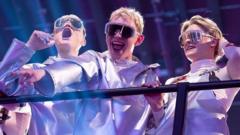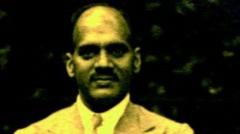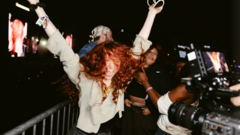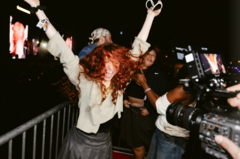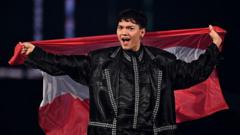In the heart of the Eurovision stage, a meticulously coordinated crew is tasked with an extraordinary challenge: changing sets between performances in just 35 seconds. This swift transition relies on a tightly organized system reminiscent of a Formula 1 pit stop, with each member playing a specific role in the seamless choreography of backstage operations.
“We refer to it as the Formula 1 tyre change,” explains Richard van Rouwendaal, the Dutch stage manager overseeing the operation. Each crew member, armed with a singular focus - whether it's carrying a prop or a light bulb - must follow specific pathways to avoid collisions, likening the precision to ice skating.
Weeks of preparation lead up to this moment. Before the contestants even arrive, stand-ins rehearse their performances while stagehands work to shave seconds off the changeover time. “We have roughly two weeks to organize the team, matching each person's strengths to their tasks," Van Rouwendaal shares, as he manages a mix of 13 Dutch crew members and around 30 locals in Basel.
Each performance requires a spotless stage, which is why the crew includes dedicated cleaners, integral for ensuring no traces of previous acts remain visible. "Our cleaners are just as vital as the stage crew. A clean stage is crucial, especially for camera angles," he adds.
Not only do crew members handle the transitions, but they also manage stage lighting and pyrotechnics for each act. Recent Eurosong performances have seen elaborate props take center stage, including a magical food blender, disco balls, and even a giant staircase.
“Props come in and out like a well-oiled machine,” explains Damaris Reist, deputy head of production for this year’s contest. “They’re systematically queued and transitioned from the left to right of the stage.” In addition to sets, these props enhance the interactive viewing experience that Eurovision is known for.
However, not every performance runs smoothly. Richard recalls a particularly challenging year in Turin, where stage heights complicated prop movements. Despite these challenges, they adapt quickly, sometimes employing secret passages to mask last-minute changes.
In the face of unexpected mishaps—like a broken camera or a misplaced prop—the crew is trained with contingency plans. If Richard calls out "stage not clear," the director can buy time to show a crowd shot, expertly ensuring viewers hardly notice any disruptions.
As the contest approaches, the pressure mounts even further. Crew members and organizers often endure 20-hour days leading up to the live event. Yet, through the stress, camaraderie thrives. Richard humorously notes, “We’ve created our little retreat backstage with stroopwafels and pancakes, maintaining a fun atmosphere is key to our success.”
At Eurovision, it’s these invisible crew members who ensure that every moment glitters on stage, allowing the performances to shine without interruption. If all goes well, their tireless efforts will remain unseen, a testament to the work that goes into crafting a flawless production.
“We refer to it as the Formula 1 tyre change,” explains Richard van Rouwendaal, the Dutch stage manager overseeing the operation. Each crew member, armed with a singular focus - whether it's carrying a prop or a light bulb - must follow specific pathways to avoid collisions, likening the precision to ice skating.
Weeks of preparation lead up to this moment. Before the contestants even arrive, stand-ins rehearse their performances while stagehands work to shave seconds off the changeover time. “We have roughly two weeks to organize the team, matching each person's strengths to their tasks," Van Rouwendaal shares, as he manages a mix of 13 Dutch crew members and around 30 locals in Basel.
Each performance requires a spotless stage, which is why the crew includes dedicated cleaners, integral for ensuring no traces of previous acts remain visible. "Our cleaners are just as vital as the stage crew. A clean stage is crucial, especially for camera angles," he adds.
Not only do crew members handle the transitions, but they also manage stage lighting and pyrotechnics for each act. Recent Eurosong performances have seen elaborate props take center stage, including a magical food blender, disco balls, and even a giant staircase.
“Props come in and out like a well-oiled machine,” explains Damaris Reist, deputy head of production for this year’s contest. “They’re systematically queued and transitioned from the left to right of the stage.” In addition to sets, these props enhance the interactive viewing experience that Eurovision is known for.
However, not every performance runs smoothly. Richard recalls a particularly challenging year in Turin, where stage heights complicated prop movements. Despite these challenges, they adapt quickly, sometimes employing secret passages to mask last-minute changes.
In the face of unexpected mishaps—like a broken camera or a misplaced prop—the crew is trained with contingency plans. If Richard calls out "stage not clear," the director can buy time to show a crowd shot, expertly ensuring viewers hardly notice any disruptions.
As the contest approaches, the pressure mounts even further. Crew members and organizers often endure 20-hour days leading up to the live event. Yet, through the stress, camaraderie thrives. Richard humorously notes, “We’ve created our little retreat backstage with stroopwafels and pancakes, maintaining a fun atmosphere is key to our success.”
At Eurovision, it’s these invisible crew members who ensure that every moment glitters on stage, allowing the performances to shine without interruption. If all goes well, their tireless efforts will remain unseen, a testament to the work that goes into crafting a flawless production.

